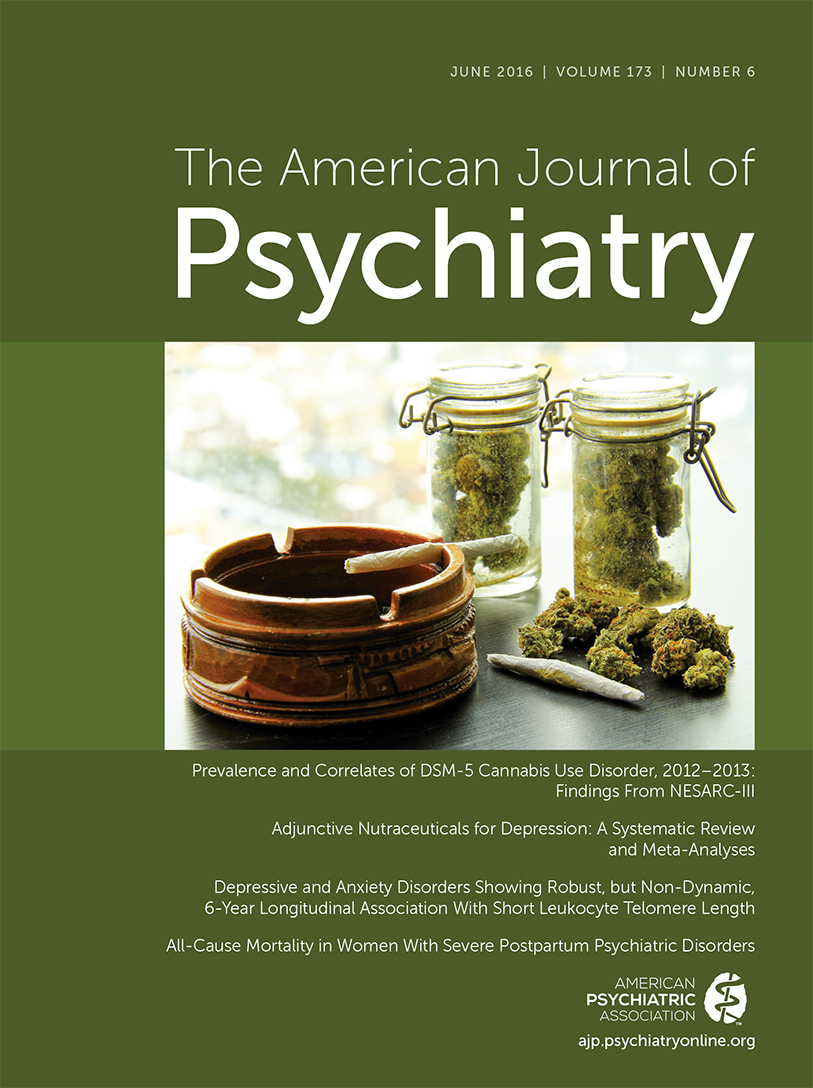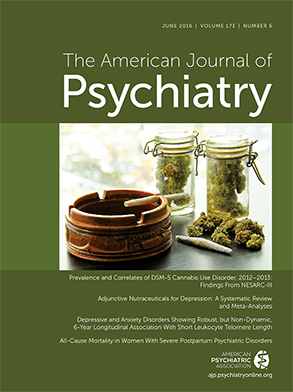In this issue of the
Journal, Verhoeven and colleagues (
1) further document the association between depressive and anxiety disorders and shorter leukocyte telomere length (LTL), an indicator of cellular aging. The researchers, reporting data from 2,936 participants in the Netherlands Study of Depression and Anxiety (NESDA) (
2), observed that participants with remitted and with current depressive and anxiety disorders show shorter LTL than never-affected controls across baseline and 6-year follow-up. The researchers controlled for lifestyle and somatic health variables known also to affect telomere length. As illustrated in Figure 2 of their report, the longitudinal course of illness over 6 years (e.g., new onset, persistent remission, relapse, chronic) was not associated with differences in LTL attrition rates. The investigators conclude that short LTL could be either a long-term consequence (“imprint”) of depression and anxiety or a biomarker of an underlying vulnerability factor for these common mental disorders. The study was not designed to address this conundrum conclusively.
What is new about this study is its focus on the longitudinal course of illness and LTL attrition. In a previous cross-sectional report published in
Molecular Psychiatry and addressing depression and accelerated cellular aging (
3), the investigators observed significantly shorter LTL in both currently depressed (5,461 base pairs) and remitted (5,459 base pairs) patients compared with controls (5,541 base pairs). These differences in length were estimated to be the equivalent of 4–6 years of accelerated physiologic—not chronologic—aging. As in the current study, the large sample size of NESDA participants permitted control for potential confounders such as smoking, body mass index, alcohol use, and physical activity. In the
Molecular Psychiatry report, the investigators reported evidence of a dose-response gradient: both depression severity and duration of depressive symptoms in the previous 4 years were associated with shorter telomeres. That relationship appears not to have been confirmed in the current longitudinal study, which offered a much finer-grained analysis of illness course. The researchers have posited that prior depression leaves a telomere scar even after the episode is over—that is, an “imprint” of past exposure to depression. They raise further questions of profound public health and clinical moment, for example, does telomere shortening contribute to medical comorbidities commonly seen in depressed patients, such as heart disease, diabetes, obesity, and cancer? Finally, they point out that how telomere length relates to treatment response is still unclear, although in the current report LTL was not found to be associated with cumulative antidepressant exposure.
In order to place these observations in further context, this commentary will first summarize contemporary understanding of what telomeres are, their function, and their relationship to cellular aging. Secondly, the commentary will offer several observations emerging in the literature of geroscience that account for mechanisms of telomere shortening and the relevance of these mechanisms to common mental disorders like depression. Finally, to recapture a clinical perspective, recent observations relating depression treatment to reductions in mortality secondary to cancer will be summarized.
What are Telomeres?
Telomeres are DNA-protein structures at both ends of each chromosome (sometimes likened to the plastic caps at the end of shoelaces). Their function is to protect the genome from degradation, and, as such, they preserve the information in the genome. A small portion of telomeric DNA is lost with each cell division, with the cell eventually undergoing senescence (inability for further cell division) and/or apoptosis (programmed cell death). Thus, telomere length can be understood as a “biological clock” related to the lifespan of a cell and organism. In essence, telomere length shortens with both physiologic and chronological age, and the rate of telomere shortening may indicate the pace of biological aging.
Telomeres and Lifestyle Factors
Lifestyle factors, including smoking (which may expedite telomere shortening and the process of aging), lack of physical activity, and obesity can increase the rate of telomere shortening, cancer risk, and pace of aging. In older adults, individuals with shorter telomeres have greater mortality rates than those with longer telomeres (
4). Furthermore, shorter telomeres are a risk factor for cancer of the lung, bladder, renal cell, gastrointestinal tract, and head and neck (
5). Of particular relevance to common mental disorders, stress has been shown to increase the rate of telomere shortening and of aging, possibly mediated by the release of glucocorticoid hormones and increased oxidative damage to DNA. The work of Epel and colleagues (
6), published in the
Proceedings of the National Academy of Science, has shown accelerated telomere shortening in response to life stress in women under chronic stress, equivalent to 10 years of life.
Geroscience, Aging, and Depression: Slowing or Reversing Telomere Attrition
What can be done to arrest the premature aging process? Clues may be found in the emerging discipline of “geroscience,” which seeks to understand how cellular and subcellular processes of aging enable diseases, such as cancer and dementia. The Trans-NIH GeroScience Interest Group has described “pillars of aging” to underscore both the multifactorial nature of the biology of aging and the interconnectedness of biological processes that underlie aging (
7). Hallmarks of the biology of aging that may have relevance to depression include genomic instability, telomere attrition, cellular senescence, deregulated nutrient sensing, mitochondrial dysfunction, and altered intercellular communication (
8). In the context of depression, especially in older adults, the neuroprotective effects of physical activity are increasingly well established and may be mediated by pathways especially relevant to co-occurring depression and diabetes, including anti-inflammatory effects, neurotrophic support, and promotion of neurovascular health. All are important pathways associated with depression and cognitive health in the later years of life (
9).
Depression, Aging, and Cancer: Is there a Connection?
Prospective studies have consistently shown a relationship between depression and increased mortality, especially in older adults. Does evidence-informed treatment prolong life? In an 8-year follow-up to the PROSPECT study of depression care management in older primary care patients, we observed a 24% reduction in mortality rates among patients in practices randomly assigned to the intervention arm of PROSPECT, compared with morality rates in usual-care practices (
10). The reduction in mortality risk was attributable to reductions in cancer-related deaths. One can invoke both behavioral and biological mediators of this effect. Patients with depression treated to sustained remission are more likely to make healthier lifestyle choices and to engage effectively in their own medical care, including screenings for cancer. At the same time, however, it is possible that achieving and maintaining remission of depression may repay benefits at a cellular and subcellular level with respect to rates of telomere attrition, thereby altering the risk architecture for cancer and its associated mortality risk.
Summary: Implications for Research Agenda
Is cellular aging in common mental disorders a permanent imprint, or is it a reversible process? While the NESDA observational study cannot answer that question, it nonetheless underscores the importance of the question and of experimental studies that can provide answers. Going forward, interventional studies in depression using both behavioral and somatic modalities can probe the underlying biology of aging. Doing so could allow us to develop further understanding of how variability in illness course, treatment response, and rate of cellular aging are connected (the foundational issue of the current study) and may shed light on the prevention of downstream sequelae of depression and anxiety, including cancer and dementing illnesses, both of which are enabled by aging processes at the cellular and subcellular level.

